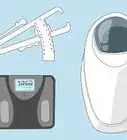This article was co-authored by Michele Dolan. Michele Dolan is a BCRPA certified Personal Trainer in British Columbia. She has been a personal trainer and fitness instructor since 2002.
There are 14 references cited in this article, which can be found at the bottom of the page.
This article has been viewed 262,490 times.
Body fat percentage is an important measure of health, considered more useful and accurate than weight or body mass index (BMI) alone. Body fat is stored in the connective tissue known as adipose tissue.[1] You gain body fat if you eat more calories than your body uses, which raises your risk of obesity and chronic disease, such as heart disease, stroke, diabetes, arthritis, and some cancers.[2] Body fat is thus a useful metric to track the progress of an exercise and diet regimen. Many tools for measuring body fat percentage are available, but these vary in terms of affordability, access, and accuracy. Among these, body fat calipers are a widely available option, but can be tricky to use to get accurate results.
Steps
Using Body Fat Calipers
-
1Enlist professional help to get the most accurate results. Experience counts when using skinfold calipers because the accuracy of the test depends on precision of measurement. “Competent” examiners have executed 50 – 100 tests in controlled research settings.[3] Experienced examiners are more likely to take measurements at the same point over time, which will give you the most accurate results for tracking your progress.
-
2Ask a friend to help. If a professional is not administering your test, keep in mind that collecting measurements from certain points, such as your back, may be difficult — if not impossible — on your own.Advertisement
-
3Learn how calipers work. Body fat calipers do not measure body fat percentage directly. They are used to administer the “pinch test,” which takes measurements of skinfolds from three to ten points on the body.[4] That information is then plugged into a formula to compute your body fat percentage. The accuracy of skinfold calipers for measuring body fat percentage depends on both the experience of the person using the calipers and the formula used to compute the results.
-
4Select a sensible formula. There are over 100 equations used to calculate body fat percentage from a pinch test. Each is specific to groups of people according to characteristics such as age, gender, race, and fitness level, which affect where bodies tend to store adipose fat. Plugging in the same data to several different equations can return results that vary by several percentage points.[5]
- Common equations include Jackson & Pollock, Parrillo, and Navy Tape.
- To choose a formula that makes sense for you, work with a fitness professional and use it as a benchmark of your progress. Or, forgo the formula completely and just keep track of the skinfold measurements.[6]
- Many body fat calculators are available online, making it easy to calculate the results of a pinch test with a few or several measurements.[7]
-
5Track your progress. At the start of a fitness regimen to reduce your body fat percentage, it is useful to get a baseline measurement. Keep this information in a log (personal training journals and fitness apps are good options) along with your exercise routine (e.g., mileage walked, weightlifting sets) over time.
- Recommended ranges for a healthy percentage of body fat differ according to gender, age, and fitness level. Women with more than 32% of body fat and men with more than 26% of body fat are considered obese.[8]
- If you’re trying to lose body fat, taking weekly measurements can help you adjust your fitness routine to improve your results. If you want to maintain your current body fat composition, monthly measurements may be more useful.
- Get a set of skinfold calipers. There are many types of calipers available on the consumer market. Ideally, an experienced examiner is administering the pinch test for you and has good-quality calipers. If you are administering the test yourself, you can purchase calipers at many different price points (from a few dollars to a couple hundred) and from many different retailers.
- You may want to invest in high-quality calipers, which will be more expensive. Cheap calipers may not exert the appropriate amount of constant pressure necessary to provide adequate tension control and reliable results. Some highly recommended calipers include Harpenden Skinfold Calipers, Lafayette Skinfold Calipers, Lange Calipers, Slim Guide Skinfold Calipers, and Accu-Measure Body Fat Calipers.[9]
Administering the Pinch Test
-
1Choose a test. Pinch tests measure skinfolds at three, four, seven, and even ten points on the body. Taking measurements from more points does not ensure accuracy of the body fat percentage calculation. That depends on the precision used when taking the measurements and the formula used to calculate body fat.
-
2Identify the points at which you'll take measurements. The key is to be consistent with the exact locations as well as pinch-type (vertical vs. horizontal). In general, the right side of the body on a standing subject is used when obtaining measurements. Common areas to measure skinfolds include:[10]
- Triceps — Have the subject bend the elbow to 90 degrees and mark the point midway between the top of the shoulder and elbow.[11] Then, measure a vertical fold (with the calipers at a 90 degree angle) at that midway point with the arm hanging naturally at the subject's side.
- Biceps — With the arm extended naturally at the subject’s side, take a vertical fold at the front of the arm, halfway between the shoulder and the crook of the elbow.[12]
- Subscapular — Measurements of the subscapular area should be taken as a diagonal fold (calipers held at a 45 degree angle) across the back, just below the shoulder blade.[13]
- Thigh — Take a vertical fold on the standing leg, midway between the kneecap and the crease where the thigh meets the hip.
- Iliac crest — Have the subject hold their right arm across the body. Use a horizontal pinch to take this measurement right above the hip bone on the side of the body.[14]
- Abdominal — A measurement in the abdominal area should be a vertical fold one inch to right of navel.
- Calf — With the foot resting on a chair or platform at approximately 90 degrees, take the measurement as a vertical fold on the inside of the calf at the point with the largest circumference.[15]
- Chest — Measure the pectoral region by taking a diagonal fold midway between the nipple and upper part of the pectoral muscle at the armpit.[16]
- Axilla — The axilla area is on the side of the upper chest. A measurement here should be taken as a vertical fold directly under the center of the armpit and perpendicular to the nipple.
- Supraspinale — A measurement of the supraspinale area should be a diagonal fold at the intersection of a vertical line between the spinal (front part of iliac crest, the protrusion of the hip bone) and front part of the armpit) and a horizontal line at the top of the iliac crest.[17] This region is also called the suprailiac, in some measurement systems.
-
3Pinch a fold of skin and pull. Making a "C" with your left thumb and index finger, grab as big of a skinfold as you can until it hurts, then pull outwards.[18] Be sure that you pinch the same exact amount of skin at the same exact location for repeat measurements.
- It is important that you do not exclude any "pinchable" skin nor include any underlying muscle.
-
4Hold the pair of calipers using your right hand with the thumb on the upper arm and index finger on the lower arm. Place the jaw ends over the skinfold while continuing to pinch the skinfold with your left hand. Using your right thumb, press down where indicated on the caliper until you feel a slight click. This sound represents the correct measurement as the caliper jaws automatically stop at the width of your skinfold. Repeat this step three times for each landmark to ensure reliability. If the measurements differ (they should only differ by 1 – 2 mm[19] ), obtain and record the average of the three measurements.
- Be sure to measure the center of the skinfold between your fingers.
-
5Record measurements on paper. Be sure to record the average of all three measurements in an organized fashion to avoid confusion during calculation. Its best to use a notebook and save all measurements as a log so you may compare them as time goes on.
-
6Enter the average measurements for each point into the formula you're using. After calculating your result, record it in your fitness journal or app.
Warnings
- Various models of body fat calipers recommend varying measurements sites.⧼thumbs_response⧽
- Body fat calipers vary in accuracy up to 4 percent.⧼thumbs_response⧽
Things You'll Need
- Body fat or skinfold calipers
- Friend or experienced professional
- Non-toxic pen or marker
- Notebook or paper
- Calculator or computer
References
- ↑ http://www.merriam-webster.com/dictionary/body%20fat
- ↑ http://www.nlm.nih.gov/medlineplus/obesity.html
- ↑ http://www.sport-fitness-advisor.com/bodyfatcalipers.html
- ↑ http://www.bodybuilding.com/fun/the-idiots-guide-to-testing-your-body-fat.html
- ↑ http://www.sport-fitness-advisor.com/bodyfatcalipers.html
- ↑ http://www.sport-fitness-advisor.com/bodyfatcalipers.html
- ↑ http://www.free-online-calculator-use.com/skin-fold-test.html
- ↑ http://www.webmd.com/diet/body-fat-measurement?page=2
- ↑ http://www.sport-fitness-advisor.com/bodyfatcalipers.html
- ↑ http://www.topendsports.com/testing/skinfold-sites.htm
- ↑ https://www.youtube.com/watch?v=hvC2TDs95xY
- ↑ http://www.brianmac.co.uk/fatcent.htm
- ↑ http://www.brianmac.co.uk/fatcent.htm
- ↑ http://www.topendsports.com/testing/skinfold-iliac-crest.htm
- ↑ http://www.topendsports.com/testing/skinfold-medial-calf.htm
- ↑ http://www.weightrainer.net/skinfoldbf.html
- ↑ http://www.topendsports.com/testing/skinfold-supraspinale.htm
- ↑ https://www.muscleandstrength.com/tools/measure-bodyfat
- ↑ http://www.weightrainer.net/skinfoldbf.html
About This Article
To use body fat calipers, start by choosing a body part that's easy to pinch, like your bicep or thigh. Then, pinch the skin between your thumb and index finger, and attach the jaws of the calipers to the area. Next, press down on the calipers where indicated with your thumb until you hear a click, which means the measurement has been recorded. You should repeat this process 3 times in each spot for accuracy and write down each result. For tips on how to use the measurements to calculate your body fat, keep reading!


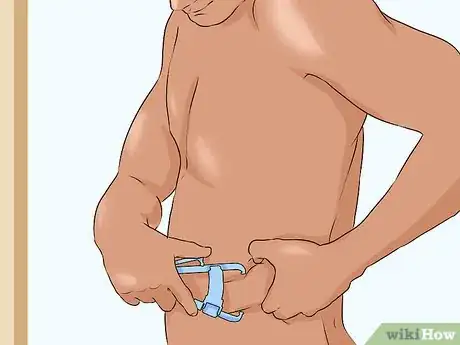



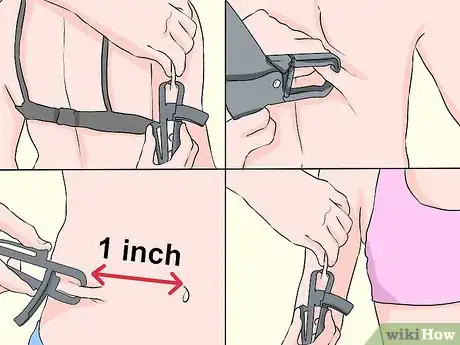

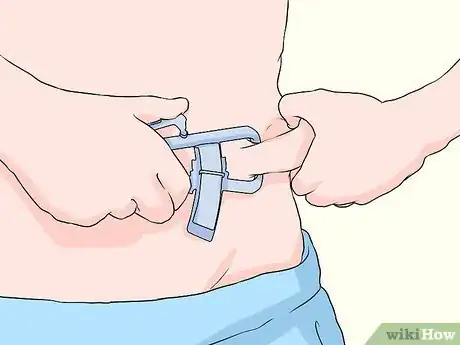
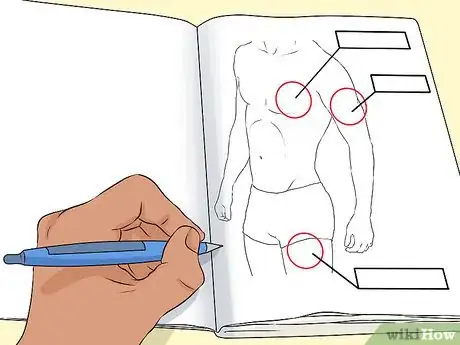
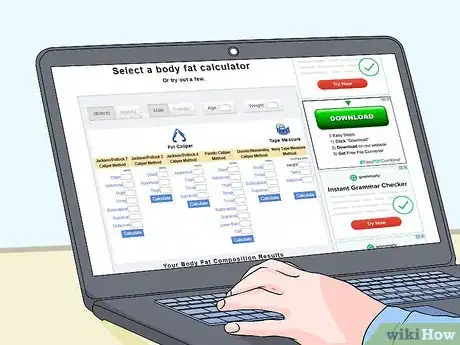


-Step-14-Version-3.webp)


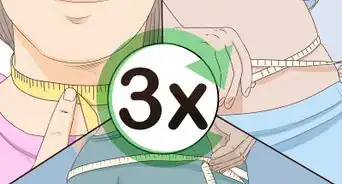





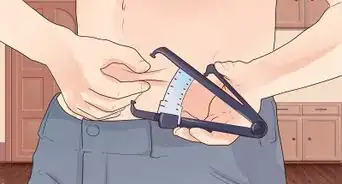













-Step-14-Version-3.webp)
